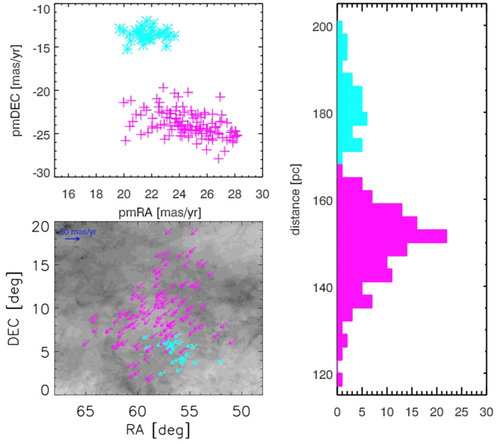Recently, two new nearby young stellar associations were discovered by the LAMOST Distinguished Young Researcher Dr. Jiaming Liu, Prof. Chao Liu from National Astronomical observatories of Chinese Academy of Sciences (NAOC), and Dr. Min Fang from the University of Arizona. These two associations are estimated to be about 50 Myr old, and located at roughly 150 pc and 180 pc from the Sun, respectively. The results have been published in the The Astronomical Journal.
Stellar associations are the least groups of stars, and they are much looser than open clusters and globular clusters. As the member stars of an association share the common origin, they usually possess similar physical and chemical properties, e.g. proper motion, distance, age and metallicity, and these properties are in turn used to identify the member stars in practice. However, the detection and confirmation of stellar associations are difficult, since they will be disturbed and disintegrated by the Galaxy. Only about 20 nearby young stellar associations have been found in last decades.
Stellar associations are important samples for investigating stellar structures formation and evolution of the local Galaxy. Among them, nearby associations are of particular significance. Being close to us, the nearby associations are conducive to the detection of faint stars, making them the ideal laboratories for the study of some important subjects, i.e. the initial mass function in low-mass range, brown dwarfs, and the formation and evolution of exoplanet systems.
In this work, taking advantage of the low-resolution spectra of LAMOST DR5 and the astrometric data from Gaia DR2, the researchers analyzed multiple parameters of the stars comprehensively. Finally, the two new stellar associations were detected: one had 35 member stars and a distance of 180 pc, and the other had 119 member stars and a distance of 150 pc. An age of about 50 Myr was also estimated for both of the two associations.
The discovery of these two new stellar associations definitely enlarges the current sample size, and will help to promote our knowledge about the general properties of stellar associations. Moreover, as these two young associations might contain some old pre-main sequence stars, they may also shed new light on our understanding about the evolution of pre-main sequence stars.

Figure: Location, proper motion and distance distribution of the two new stellar associations (cyan and magenta).
Note: pc (parsec) is a unit of length used to measure the large distances. 1 pc equates to about 3.26 light-years, which is about 206,265 times the distance between the earth and the sun.
The link to the paper: https://iopscience.iop.org/article/10.3847/1538-3881/ab6b22

Address: 20A Datun Road, Chaoyang District, Beijing, China code: 100012
Tel: 010-64888708 E-mail: naoc@nao.cas.cn

